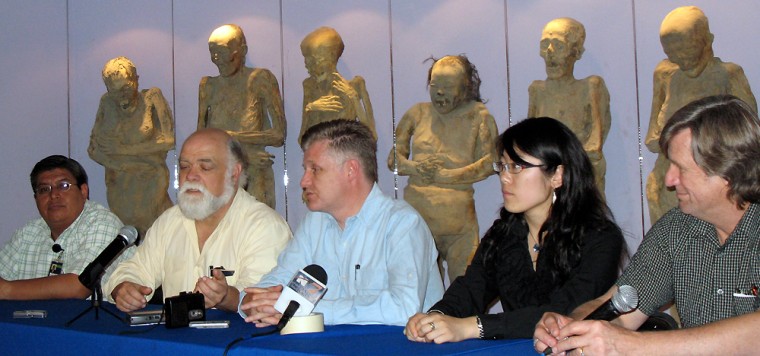People who lived in the mining town of Guanajuato, Mexico, more than a century ago left behind a scientific mother lode: their own accidentally mummified bodies.
Scientists are conducting what they say is the first intensive examination of more than 100 bodies mummified in the city, while stored in aboveground crypts from the mid-19th to mid-20th centuries. The bodies from the Guanajuato's Museo de las Momias (Museum of the Mummies) are believed to be the largest mummy collection in the Western Hemisphere.
Guanajuato Mayor Eduardo Romero Hicks invited scientists from Texas State University and Quinnipiac University in Connecticut in to find out more about the people whose remains are on display at the museum.
"What we're hoping to do with the scientific research ... is that when you come to see the mummies it's going to be like meeting a person," said Ronald Beckett, a Quinnipiac cardiopulmonary sciences professor and former co-host of "The Mummy Road Show" on the National Geographic Channel.
"We're going to try and get these individuals to tell us their story, which can then be there on the display, so you're not just looking at an individual who was mummified by the crypts there in Guanajuato," Beckett said Thursday as researchers announced their preliminary findings in Hartford.
According to local legend, the bodies are so well preserved because the city's water is rich with minerals and sulfur. But the researchers believe the hot weather warmed the crypts and the bodies dried out.
The first mummy is believed to have been discovered in 1865, when the body of a French physician was removed from a cemetery crypt because a burial tax had not been paid. The cemetery began storing mummies in a nearby building, and a museum was opened in the late 1800s.

The scientists examined 22 mummies during a trip to Guanajuato in May and plan to return next year to look at the rest; no mummies were removed from the city. Funds are being provided by Quinnipiac, Guanajuato's government and the researchers themselves.
"The general picture that's coming out of this community is that these individuals were hardworking," Beckett said. "There was a lot of arthritis from wear and tear from hard work."
Researchers also found evidence of infectious diseases like tuberculosis, and the many mummified children were a reminder of the high infant and child mortality rates of the 1800s and early 1900s.
Among the mummies were an infant and a fetus that had both been cut open and closed with sutures, possibly indicating embalming or autopsies. No other mummies had signs of embalming.
A man and a woman who had appeared to have been hanged were found to have no internal damage to their throats. Beckett said the external markings on the mummies' throats may have been caused by the high-collared clothing in which they were buried.
Researchers are using various techniques to examine the mummies, including looking inside them with endoscopes, taking X-rays and measuring bones. They also hope DNA experts become interested and offer to analyze samples of hair and a placenta taken from the bodies.
Beckett and Quinnipiac colleague Gerald Conlogue first studied the mummies in 2001 for "The Mummy Road Show," but Beckett said the latest research is the first-ever intensive examination of the collection.
The mayor, a medical doctor, said his goal is to find out as much as possible about the people who were mummified and treat the bodies with respect. He said no relatives of any of the mummies have been found or have come forward.
"They're not just a bunch of mummies lying around," Romero said. "If we have a body on display, I think he has a right to tell his story."
